There are 37 different species of snake that live in North Carolina alone. Some of them are dangerous, while some of them are just a nuisance, but no matter their level of danger almost every type of snake is a creature that you don’t want slithering around your property. Still, sometimes in North Carolina a snake presence is inevitable, which is why knowing what kind of snake you’re dealing with is especially important. Read on to see our guide on North Carolina snakes.
COMMON SNAKES IN NORTH CAROLINA
As we mentioned above, North Carolina is home to 37 different species of snake. But instead of focusing on each and every one of them, we are instead going to look at the 10 most common.
Non-Venomous Snakes
GARTER SNAKES
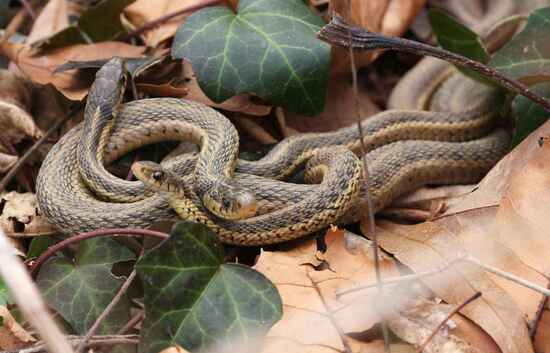
Garter snakes are anywhere from 3-4 feet long, and come in a variation of colors — including red, black, gray, and brown. They are distinctive for the 3 stripes along their bodies, which are typically either white or yellow. Usually garter snakes are found in woods and marshes, but they can also make their way into your backyard; essentially they will settle down in any area that can provide some cover for them. A garter snake’s diet consists of frogs & toads, fish, and worms, as well as insects and other pests. Luckily they pose little to no threat to humans and pets, and can in fact be good to have around because of their diets.
EASTERN KINGSNAKES
Eastern kingsnakes are 3-5 feet long, and are black-colored with a white/light yellow chain-pattern across their bodies. This species of snake is relatively shy, but they can also be brutal: when they hunt they kill by squeezing, which classifies them as “constrictors”. They are also unusual because of their immunity to other snake’s venom, which comes in handy when they kill and eat other snakes (which they do!) On the whole eastern kingsnakes are rarely if ever a true threat to people, but they can become aggressive when they feel threatened.
RAT SNAKES
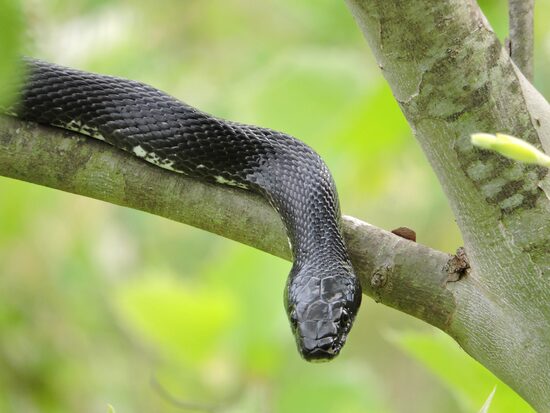
Rat snakes (also known as Elaphe [Pantherophis] obsoleta) are also usually in the range of 3-5 feet long, but can sometimes grow to be as long as 6 feet in length. These snakes can differ wildly in appearance, with some being black, some greenish-yellow, and some gray. These snakes largely eat rodents and birds, with mice, rats, and squirrels all a part of their diet. They also kill by constriction, but like the snakes listed above they are not a particular threat to humans or pets — unless of course, you have a pet rat!
LITTLE BROWN SNAKES

Little brown snakes are- as their name suggests- a small snake, especially when compared to the garter snake, eastern kingsnake, and rat snakes. More commonly known as the Dekay Brown Snake, they measure anywhere between 6 and 13 inches long, and are typically brown — although they can also be grayish-brown, yellowish, or even reddish in color. Little brown snakes are one of the most common snakes found in residential and urban settings, which sets them apart from the snakes we’ve talked about so far in this guide. Because of their smaller size, they do not eat small mammals but instead hunt for easier prey like slugs and earthworms. Unlike the dangerous brown snakes found in Australia, these small and shy snakes are non-venomous and pose little threat to humans or pets.
Venomous Snakes
EASTERN CORAL SNAKES
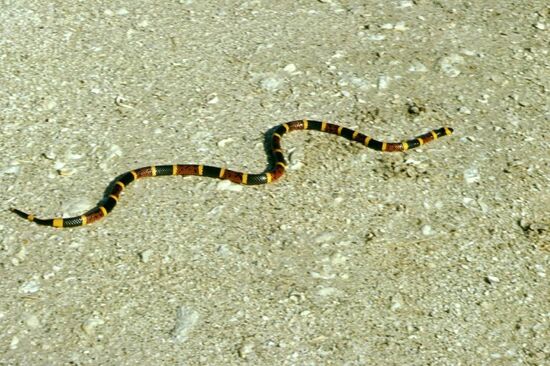
Eastern coral snakes are somewhat isolated in North Carolina- they are only found in the southeastern most part of the state– but that doesn’t mean you don’t need to worry about them, because they are venomous. Coral snakes have a body consisting of red, yellow, and black rings, with a blunt, black snout. These venomous snakes live in sandy areas, and generally spend most of their time underground, but if you are victim to one of their venomous bites, their venom will attack your central nervous system. But don’t worry too much! Eastern coral snakes are considered endangered in North Carolina, which means your chances of encountering one is slim; in fact you’d probably have to go looking for one to actually see it in the wild.
COPPERHEAD SNAKES

As far as venomous snakes go, copperheads are definitely the most common and familiar to North Carolinians. Measuring in at 2-3 feet long, these snakes are not by any means the largest in this guide, but they are one of the most aggressive. Their dark brown/reddish-brown crossbands and copper color makes them blend into some environments rather seamlessly, which paired with their aggressive nature can make them a dangerous snake to encounter indeed. Despite their venomous bites and aggressive nature, copperhead snake bites are luckily not usually fatal to humans or pets, but for young children and the elderly their bites can be more consequential, and in any case medical attention should be sought ASAP.
COTTONMOUTH SNAKES
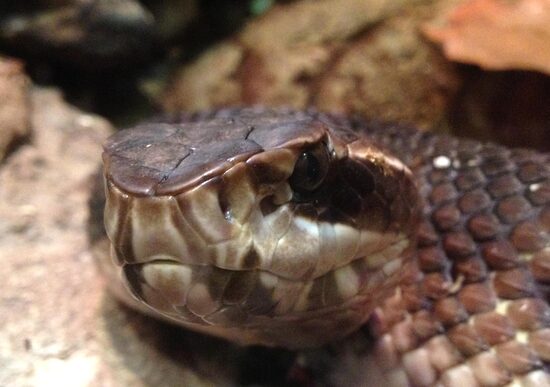
Cottonmouth snakes, sometimes referred to as “water moccasins”, are venomous snakes that measure around 2-4 feet long. They vary in color, sometimes brown or yellow with dark crossbands, and sometimes completely brown or black with no crossbands at all. They are considered freshwater snakes, which means that they can be found in swamps, floodplains, and wetlands. They are the fourth most venomous snake in North Carolina (more venomous than copperhead snakes), but luckily their aggression levels are much lower than copperheads.
RATTLESNAKES
There are 3 types of rattlesnakes that reside in North Carolina, each of them differing in appearance and preferred habitat. According to the North Carolina Wildlife Resources Commission, this is how they differ from one another:
EASTERN DIAMONDBACK RATTLESNAKES
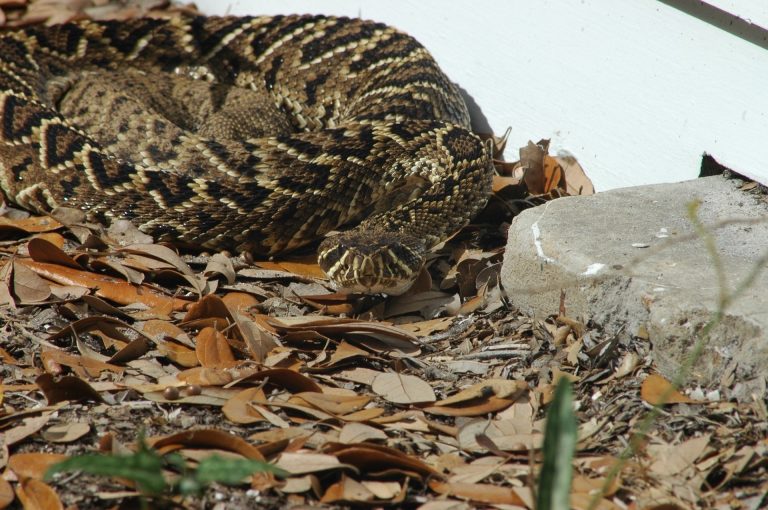
- The world’s largest rattlesnake species — measuring up to 6 feet long
- Average 28 dark, diamond-shaped markings with pale borders.
- Triangular-shaped head with dark bands masking eyes.
- 2 light lines running along sides of head.
- Rattle on end of tail.
- Found in southeastern Coastal Plain in longleaf pine flatwoods and sandhill habitats.
TIMBER “CANEBRAKE” RATTLESNAKE

- Up to 5 ½ feet long.
- Dark crossbands with lighter background body color.
- Black-tailed.
- Rattle on the end of the tail.
- most common in the Mountains and Coastal Plain in North Carolina.
- Found primarily in forested areas.
PIGMY RATTLESNAKE
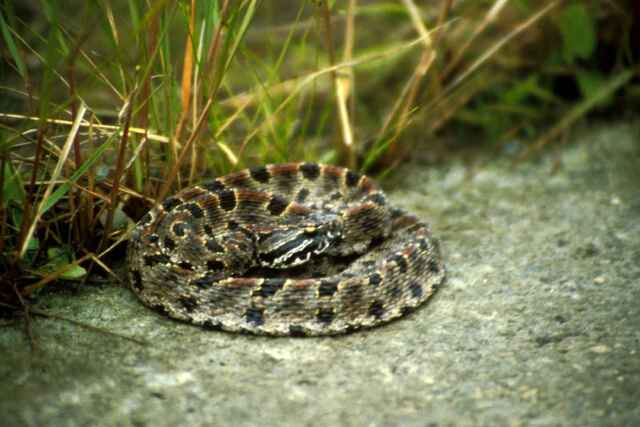
- Average size 15-21 inches — the smallest rattlesnake in North Carolina.
- Dull gray with a row of dark spots down center of the back and a smaller row of spots along sides.
- Snakes from outer Coastal Plain counties often have a red or pinkish background color.
- Small rattle that often sounds like an insect buzz.
- Found mostly in pine flatwoods and scrub oak habitats in southeastern Coastal Plain, Sandhills, and a few portions of southern Piedmont.
HOW TO PREVENT SNAKE BITES
So what can you do to protect yourself and your family from potentially dangerous snakes — and their bites? According to the American Academy of Family Physicians, there are a few simple things that you can do:
- Avoid places where snakes may live. These places include tall grass or brush, rocky areas, fallen logs, bluffs, swamps, marshes, and deep holes in the ground.
- When moving through tall grass or weeds, poke at the ground in front of you with a long stick to scare away snakes.
- Watch where you step and where you sit when outdoors.
- Wear loose, long pants and high, thick leather or rubber boots.
- Shine a flashlight on your path when walking outside at night.
- Never handle a snake, even if you think it is dead. Recently killed snakes may still bite by reflex.
AND IF I AM BITTEN BY A SNAKE?
The AAFP has advice on this as well:
- Stay calm.
- If you see the snake, try to remember what it looks like. Do NOT approach the snake; don’t try to catch it or to kill it.
- Take off any jewelry or tight clothing near the bite quickly, before swelling starts.
- Lift a bitten arm or leg so it is level with your heart.
- Clean the bite wound. Be sure to wipe in the direction away from the wound.
- If you think the bite was from a venomous snake, get to a hospital as soon as you can. In most of the United States, you should have time to get medical help before the bite is a serious danger to your life.
- If medical help is more than 30 minutes away, tie an elastic wrap two inches above the bite. The wrap should be loose enough to slip a finger underneath it.
- Do NOT bleed the wound.
- Do NOT try to suck the venom out of the wound.
- Do NOT put ice on the bite
FINDING SNAKE CONTROL AROUND CHARLOTTE, NC
Now that we’ve recapped some of the common dangerous- and not so dangerous- snakes around North Carolina, and how to prevent plus deal with a snake bite your next question might naturally be, “What can I do to get rid of snakes on my property?” That’s where City Wide Exterminating comes in. Our Snake Guard Plan traps any snakes currently living on your property, and also includes a snake repellent treatment to ward off any potential snake invaders. Here’s how it works:
- Search and Capture: Our snake experts will spend up to 60 minutes searching out any snakes on the property. All snakes that are captured are taken away and relocated.
- Full Inspection: Let us find out why the snakes are there. Our team will search for possible food sources that could be making your home their home. We will look for things like mice, bats, birds, and any entry points that we find. We will also provide a full-colored report of possible entry points and recommendations on fixing them.
- Trapping: This package includes 2-4 specially designed snake traps equipped with a special lure. Traps are left for 7 days and 6 nights. We will relocate any snakes caught at the end of the 7 days.
- Keep them away! After the trapping, we provide a complimentary snake repellent treatment to the foundation of the home. The repellent typically lasts about 30 days and causes no issues with pets, kids, or other animals. Looking for more than 30 days? Don’t worry, we have you covered. Additional treatments can be purchased separately!